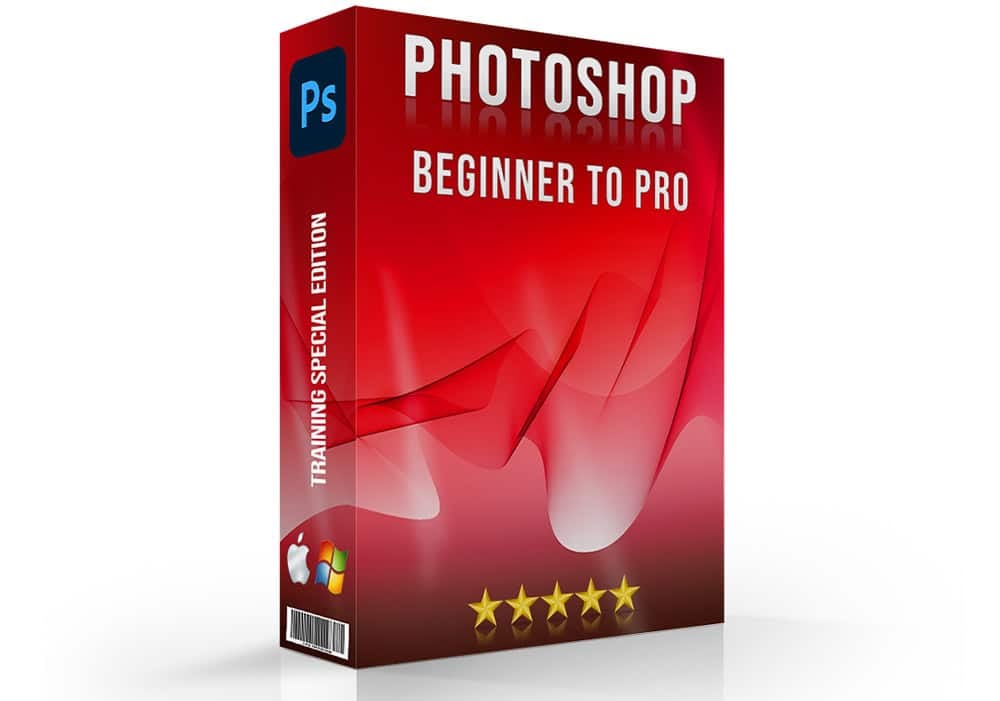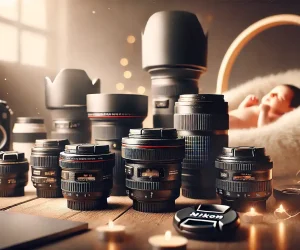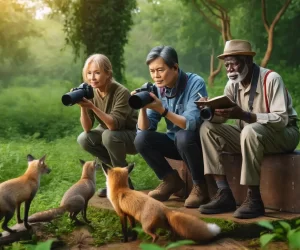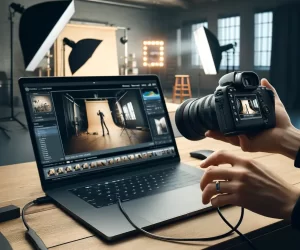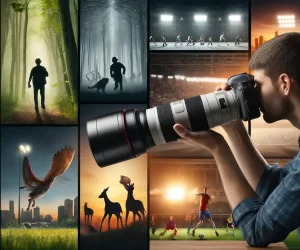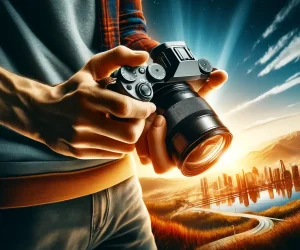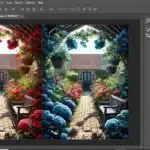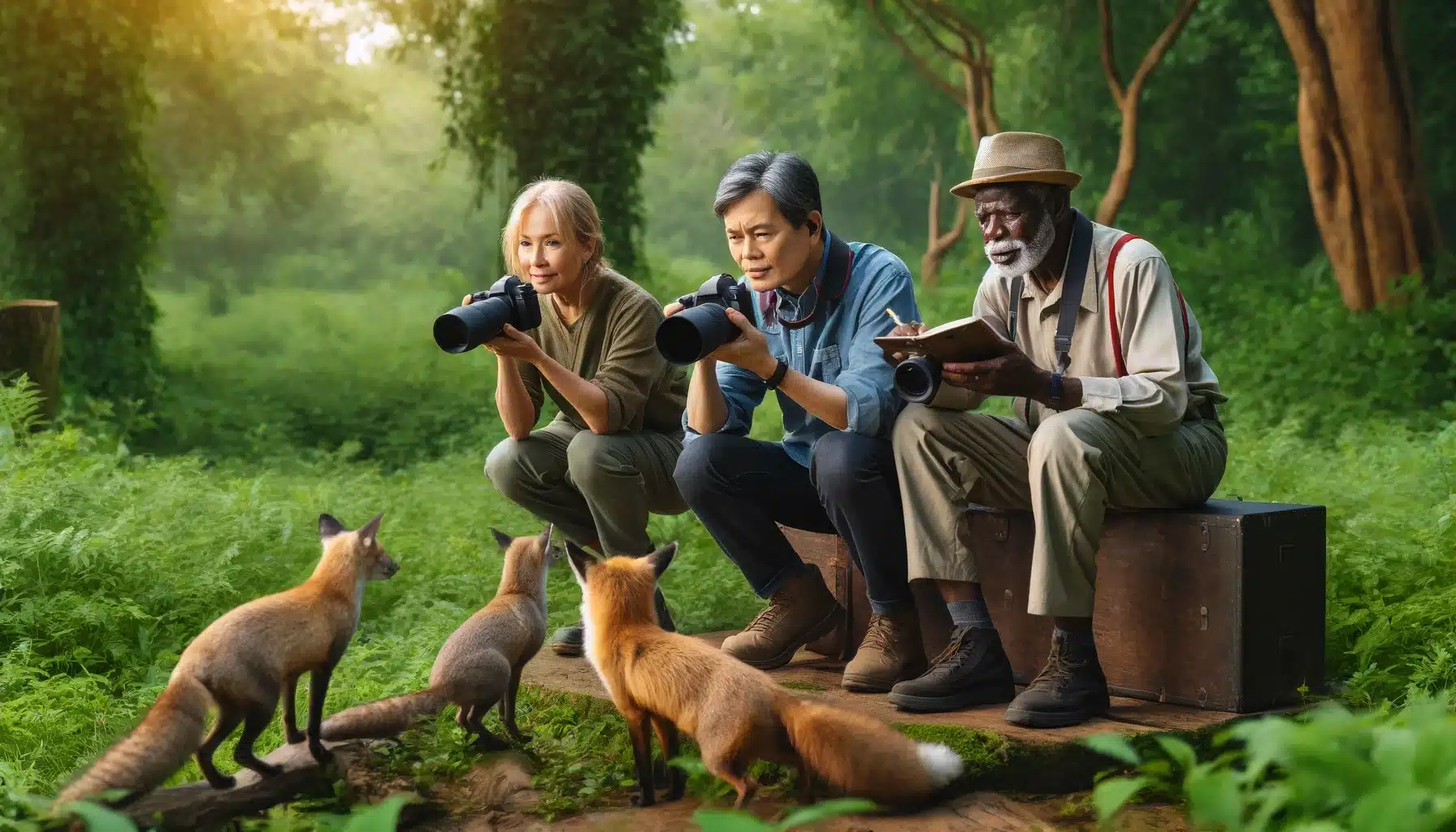
Introduction to Wildlife Photography Equipment
Embarking on a journey into wildlife photography can be thrilling and immensely rewarding. To capture stunning images of nature and its inhabitants, having the right Wildlife Photography Equipment is essential. These wildlife photography tools not only enhances the quality of your photos but also ensures you are prepared to handle various outdoor conditions. From cameras to lenses, every piece plays a vital role in helping you achieve those breathtaking shots.
For instance, consider the story of Alex, a beginner wildlife photographer who ventured into the Yellowstone National Park with just a basic camera. He quickly realized the importance of specialized wildlife photography tools when he encountered a serene scene of a grizzly bear in the early morning light. Despite his enthusiasm, his standard lens couldn’t capture the intricate details of the bear’s fur or the subtle morning mist. This experience taught him the value of investing in the right gear, like a telephoto lens and a sturdy tripod, which significantly improved his future wildlife captures.
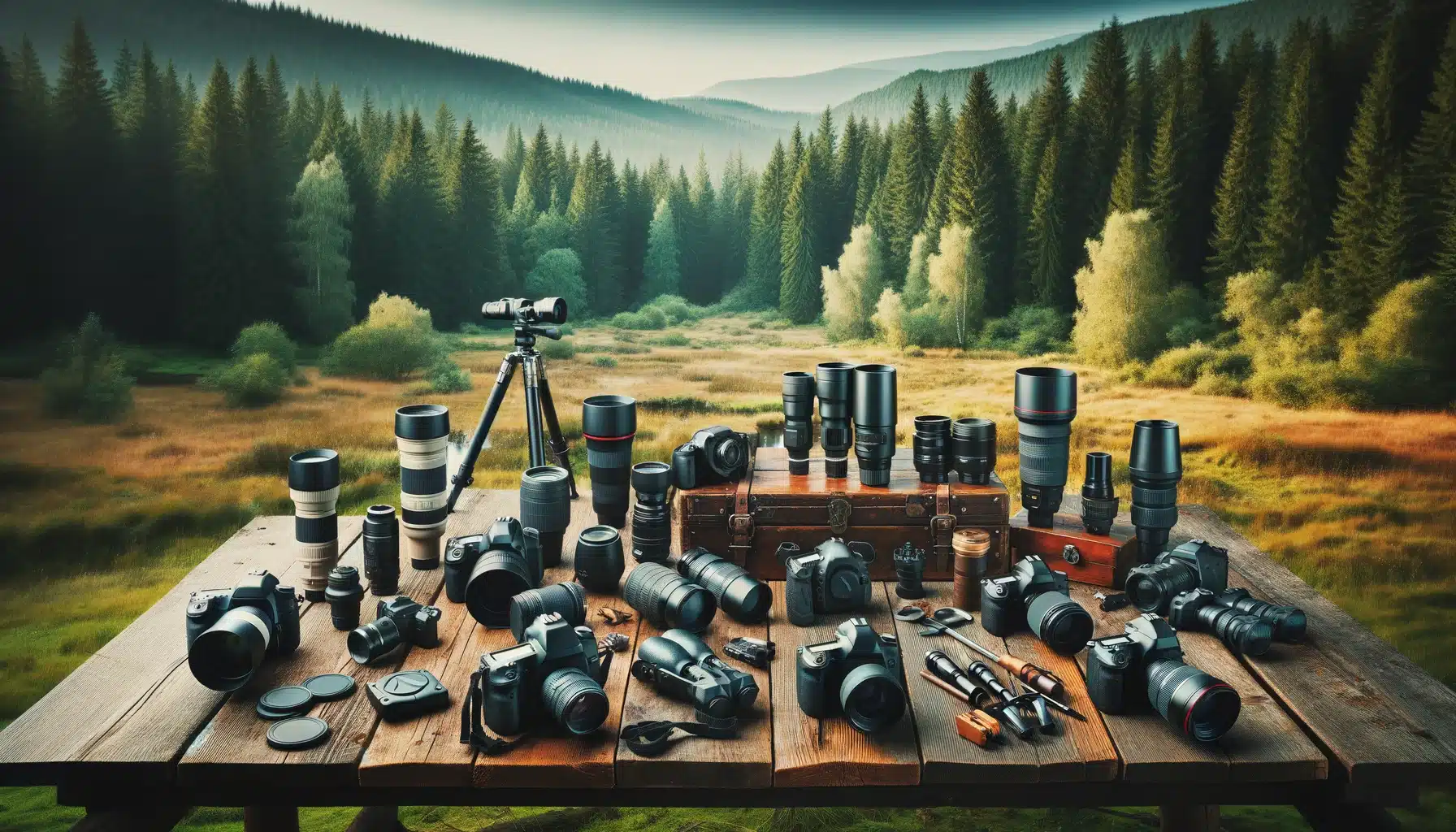
Table of Contents
Essential Wildlife Photography Kit
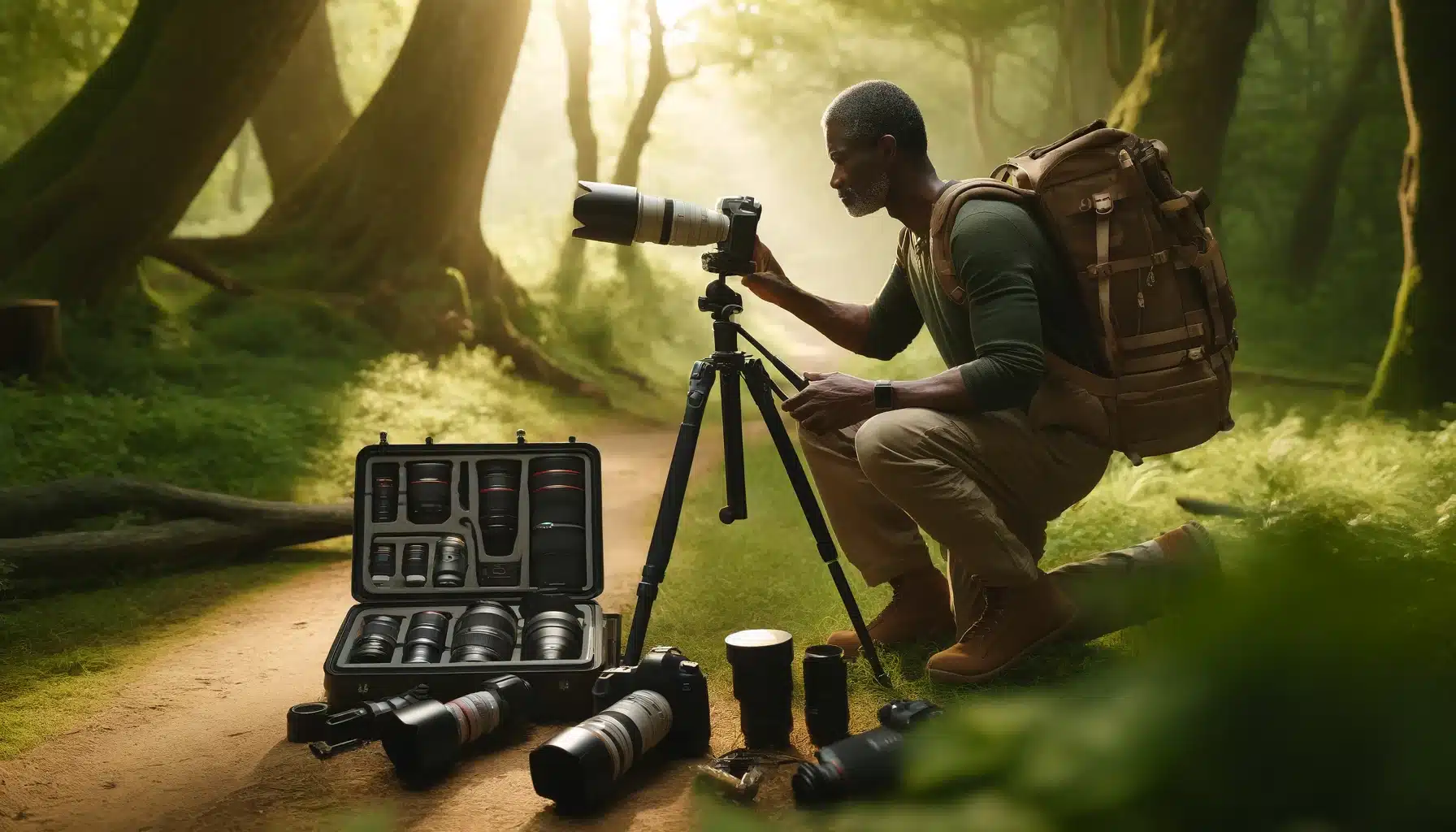
Cameras - Most Crucial Wildlife Photography Equipment
The heart of your photography setup is the camera. A robust DSLR or mirrorless camera is highly recommended as wildlife photography tools. These cameras offer high image quality, quick autofocus, and the ability to shoot rapidly, which is perfect for capturing fast-moving wildlife. Durability and weather resistance are also important for the cameras for nature shots, as wildlife photography often exposes you to harsh outdoor conditions.
Lenses That Bring Nature Closer
Your choice of lens can significantly impact the brilliance of your wildlife photos. Telephoto lenses are invaluable because they allow you to capture close-up details of animals from a safe distance. Wide-angle lenses, on the other hand, are excellent for taking shots that include the surrounding landscape, giving context to the scene and showing how animals interact with their environment. Don’t forget to clean camera lens for a better shot.
Tripods for Stability in the Wild
Using a sturdy tripod is essential when dealing with long telephoto lenses, which can be heavy and difficult to hold steady. A good tripod provides the stability needed to prevent camera shake, ensuring your images remain sharp. This is particularly crucial in low-light conditions where longer exposures are necessary to capture clear shots.
Protecting Your Nature Photography Gear
Protecting your photography equipment is just as important as the gear itself. A high-quality, weather-resistant camera bag is crucial for keeping your Nature photography gear safe from the elements. Additionally, having protective gear like lens filters can help safeguard your wildlife photography lenses from scratches and reduce glare, enhancing the overall clarity of your photos.
Choosing the Right Lenses for Wildlife Photography
- Telephoto Lenses for Distance: For wildlife that tends to keep its distance, such as photographing a bird or cautious animals, a telephoto lens is crucial. A minimum focal length of 300mm will be more suitable to capture clear, detailed shots without disturbing the animal.
- Shorter Zoom or Prime Lenses for Larger Subjects: When photographing larger animals or those that can be approached more closely, such as deer in a national park, a shorter zoom or a prime lens may be more suitable. These lenses allow for wider shots that include more of the surrounding environment, providing context to the animal's habitat.
- Choosing Lens Based on Subject and Environment: The decision on which lens to use should consider both the type of wildlife and the environment in which they are found. Different lenses can offer various perspectives and details, enhancing the storytelling aspect of your wildlife photography.
- Importance of Lens Speed: A lens with a wide aperture (low f-number) is beneficial for wildlife photography. It allows more luminosity to enter, which is especially useful in dawn or dusk settings, common times for wildlife activity. Fast lenses also offer faster shutter speeds to freeze motion, capturing crisp images of moving subjects.
- Versatility with Zoom Lenses: Zoom lenses offer flexibility in composing shots without changing your position, which is a huge advantage in wildlife photography. A lens like a 100-400mm or 150-600mm can be incredibly useful, allowing you to adjust your framing as animals move through their natural habitat.
- Considering Weather-Sealed Options: Since wildlife photography often involves exposure to various environmental conditions, choosing cameras and lenses that are weather-sealed can protect your Wildlife photography tools from dust, moisture, and debris. This can be critical for maintaining the longevity and performance of your photography equipment.
Optimal Camera Settings for Capturing Wildlife
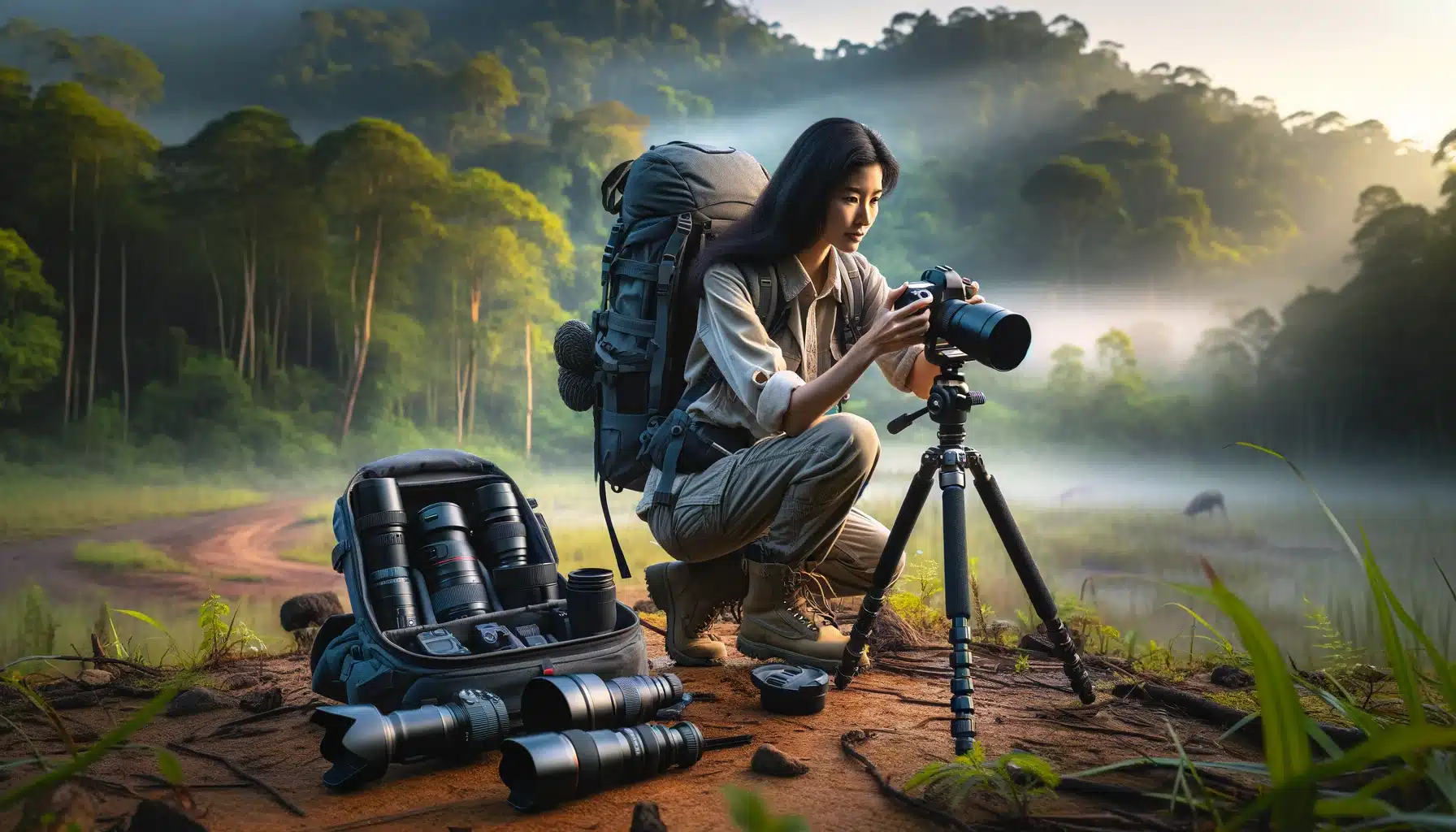
When venturing into nature to capture the essence of the wild through your lens, knowing the optimal camera settings is crucial. These settings ensure clarity and detail without disturbing the natural behavior of your subjects.
Autofocus ensures your subject remains sharply focused whether they’re still or in motion, essential for capturing the fleeting moments in nature. Shutter Speed allows for creative control over motion, enabling sharp action shots or beautifully blurred movements. Adjusting ISO helps manage the brightness sensitivity of your camera, crucial for shooting in various lighting conditions without loss of detail.
Aperture affects the depth of field and the amount of illumination entering the lens, which is vital for artistic focus effects and exposure control. Long Exposure photography is a powerful technique to create surreal effects, such as smoothing water and capturing trails of stars, providing a creative edge to your Wildlife Photography equipment.
These settings are fundamental for photographers looking to elevate their craft by fully utilizing their Wildlife photography tools, enabling them to adapt swiftly and creatively to the challenges posed by nature photography.
| Setting | Recommended Value | Purpose | When to Use |
|---|---|---|---|
| Aperture | f/4 to f/8 | Provides a balance of focus and context | Ideal for mid-range to close-up shots |
| Shutter Speed | 1/500s or faster | Freezes motion effectively | Necessary for capturing fast movements |
| ISO | 400-1600 | Adjusts to available lighting | Increases in darker settings |
| White Balance | Auto or Specific | Matches the color temperature | Adjust according to natural conditions |
| Focus Mode | Continuous AF | Keeps moving subjects in sharp focus | Best for subjects that are not stationary |
Advanced Accessories and Wildlife Photography Tools

High-Speed Memory Cards
- Reliable Storage: Opt for high-speed memory cards to ensure quick save times, which is crucial when shooting in continuous burst mode. This helps you capture multiple frames in seconds without missing critical moments.
- Capacity and Speed: Choose cards with ample storage and fast write speeds to handle large files, especially when shooting in RAW format.
External Flash Units
- Illumination Control: External flashes provide additional illumination when natural lighting is insufficient. They are particularly useful during dawn or dusk shoots.
- Adjustable Settings: Look for flashes that offer adjustable intensity and angles to enhance your control over the scene without startling your subjects.
Gimbal Heads
- Stability for Video: Gimbals ensure smooth panning and tilting movements while filming. This is essential for creating professional-level video footage in nature.
- Support Heavy Setups: They are ideal for supporting heavier camera setups, which can be difficult to stabilize manually over extended periods.
Remote Shutter Releases
- Minimize Disturbance: Using a remote shutter release allows you to take shots from a distance without causing vibrations. This is perfect for capturing natural behavior without human interference.
- Enhanced Flexibility: Remotes can be wired or wireless, giving you flexibility depending on your shooting conditions and setup.
Protective Covers
- Elemental Protection: Specialized covers and housings protect your camera and Nature Shooting Accessories from harsh environmental conditions such as rain, dust, and sand.
- Durability: Ensuring your equipment remains protected in rough conditions extends its lifespan and maintains its performance.
Practical Wildlife Photography Tips for Enhanced Field Observations
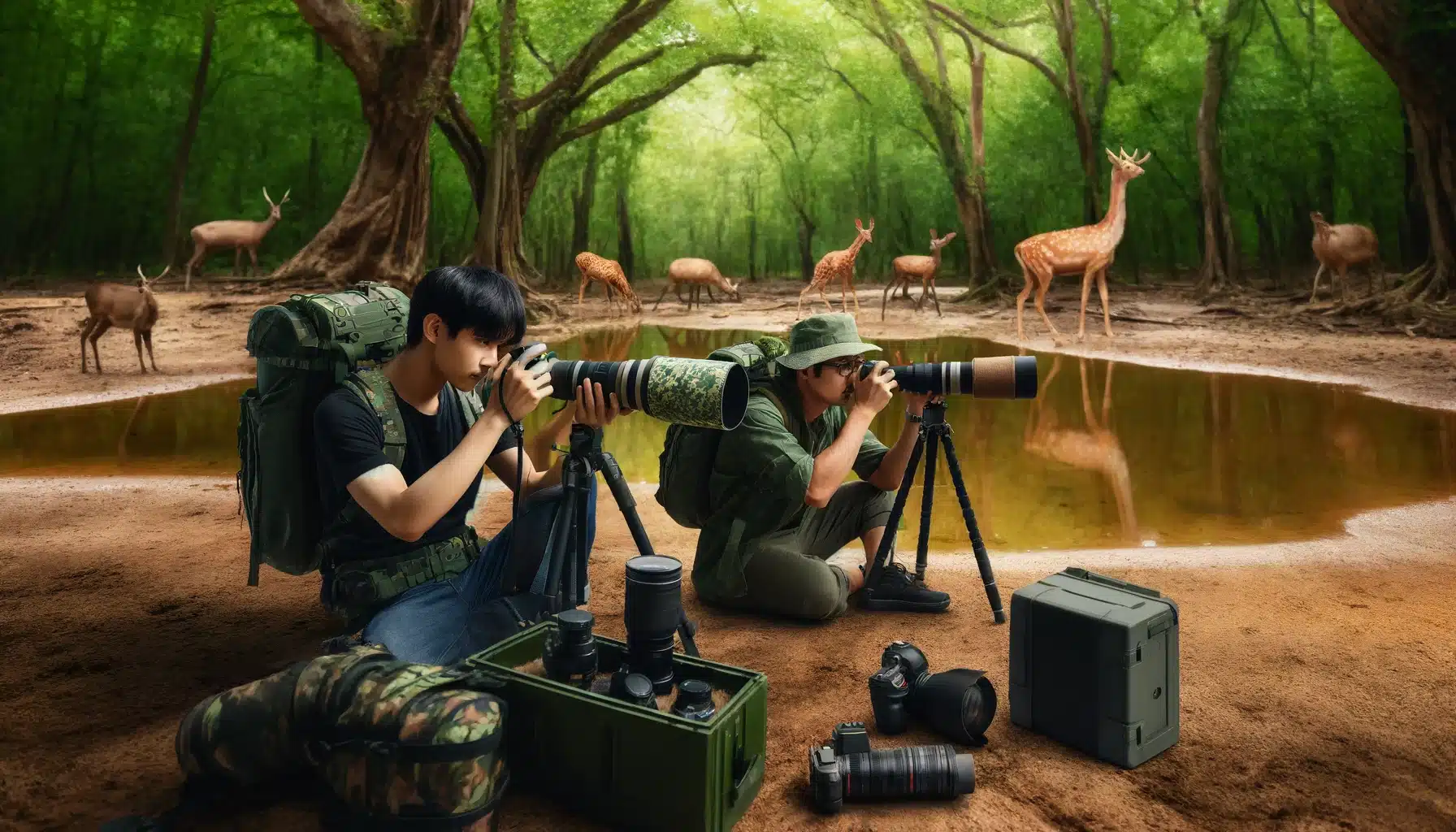
Utilize Binoculars for Strategic Positioning and Observation
- Scouting with Binoculars: Before you even unpack your wildlife photography equipment, use binoculars to explore the environment. This allows you to choose the best spot for observation without impacting the surrounding area.
- Behavioral Insight through Binoculars: Observing patterns and behaviors through binoculars can give you insights into the best times for observation, helping you anticipate key moments.
Select a Reliable Backpack for Comfortable Travel
- Choosing the Right Backpack: A robust backpack is crucial for carrying your wildlife photography equipment comfortably. Look for one with several compartments and adequate padding to safeguard your items during travel.
- Backpacks as a Flexible Travel Option: A well-organized backpack not only facilitates easier transportation of your setup but also keeps everything within reach. This is vital when you need to relocate quickly or adjust your setup on the go.
Maintain Readiness and Embrace Patience
- Be Prepared: Keep your observation tools ready, as opportunities can emerge abruptly. This includes having your setup assembled and adaptable to different environments.
- Patience Pays Off: Often, the most compelling observations are made by patiently waiting for the perfect moment. Carry essentials in your backpack to ensure comfort during prolonged periods of observation.
Optimize Observation Times During Golden Hours
- Maximize Early and Late Daylight: The soft light of early morning and late afternoon can significantly enhance the clarity of your field observations. Position yourself strategically during these times for optimal natural illumination.
- Light Travel for Efficient Movement: When transitioning between locations during these optimal hours, travel light. Bring only necessary items in your backpack, allowing for quick and discreet movement.
These nature photoshoot practical tips, focusing on the effective use of wildlife photography equipment and essential travel accessories like binoculars and a well-organized backpack, can significantly improve the sharpness and professional clarity of your captures, whether you’re refining them in Lightroom or editing in Photoshop.
Strategies and Secrets of Renowned Wildlife Photographers
Emphasizing the Right Tools: Insights from John Smith and Emily White
John Smith’s Choice of Canon: John Smith prefers Canon for its reliability and performance, finding that the EOS model gives him the edge when capturing dynamic scenes. He believes Canon offers a better body for demanding shoots, balancing price and functionality.
Emily White’s Nikon Experience: Emily White praises Nikon for its intuitive design and robust build, essential for her needs. She finds Nikon’s offerings particularly conducive to her style, emphasizing that a great body can be a game-changer.
Mastering Timing with Techniques from Alex Johnson
Alex Johnson’s Sony Strategy: Alex uses Sony due to its superior autofocus capabilities, ensuring that no critical moment is missed. The quick response time of Sony cameras allows him to capture crisp, clear shots even in fleeting moments.
Sigma Lenses for Budget-Friendly Quality: Alex also recommends Sigma lenses for those who are mindful of budget but unwilling to compromise on quality. The combination of Sigma lenses with a sturdy Sony or Nikon body often results in high-quality shots without a steep price tag.
Composition and Patience by Lisa Green
Lisa Green on Framing: Lisa emphasizes the importance of composition in photography. She uses basic principles like the rule of thirds to enhance the visual appeal of her photos, demonstrating that thoughtful composition can transform a simple photo into a stunning piece.
Valuing Patience: Lisa believes that patience is one of the most crucial skills a photographer can have. Many times, the difference between a good photo and a great one is just a matter of waiting for the perfect moment, a skill she has honed over time with her trusty Nikon.
Continuous Learning with Mark Thompson
Keeping Updated with Canon and Sony: Mark Thompson is always on the lookout for the latest advancements from Canon and Sony. He believes that keeping up-to-date with new technologies and body enhancements can significantly impact the effectiveness of his work.
Adaptation is Key: Mark is an advocate for constant learning and adaptation. Whether it’s experimenting with new Sony lenses or adapting to the latest Canon EOS features, he finds that staying flexible and open to new methods is essential for keeping his shots fresh and engaging.

FAQs for Wildlife Photography Equipment
What equipment is used for wildlife photography?
The typical setup for capturing natural scenes includes advanced imaging devices capable of detailed visuals, stabilizing wildlife photography tools like supportive stands, and high-fidelity optical enhancements for clarity at a distance. Protective accessories ensure durability against environmental conditions, and specialized carrying solutions provide convenience and protection while on the move.
What cameras do professional wildlife photographers use?
Professional capturers of natural scenes often rely on sophisticated imaging devices known for their robust build and ability to handle rapid scene changes. These devices, manufactured by renowned technology firms, are chosen for their precision, durability, and advanced features. However, Canon, Nikon, and Sony’s cameras are preferred by the photographers.
What is the minimum lens for wildlife photography?
To effectively capture distant subjects without disturbing the environment, a minimum optical enhancement of 300mm is typically required. This allows for detailed visual capture from a safe distance, ensuring the scene remains pristine and the natural behavior of subjects is not influenced by the presence of the photographer.
What is the best camera setting for wildlife photography?
For optimal capture of natural scenes, setting the device to a fast shutter speed is crucial to freeze motion, while adjusting the sensitivity settings helps in accommodating varying light conditions. The aperture should be set to balance the depth of field and exposure, ensuring detailed and well-lit visuals.
Conclusion
Throughout my journey in capturing the essence of the natural world, the right equipment and understanding its functionality have been instrumental. On a serene morning, equipped with essential wildlife photography tools and practiced patience, I captured a series of images showcasing the delicate interplay of light and scenery. This experience not only honed my skills but also deepened my appreciation for the delicate moments nature offers.
For those looking to enhance their skills in capturing and editing stunning visuals, I highly recommend exploring our detailed courses on Lightroom and Photoshop. These courses are crafted to help you refine your techniques and deepen your understanding of essential tools, enabling you to bring your creative visions to life. Embark on your journey to mastery by checking out our Photoshop course and Lightroom course today.
Have a nice photoshoot!
Learn more about Photography Equipment:

